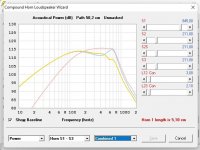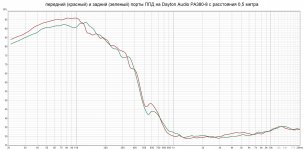Did you connect and play how is the sound. Please share experience earger to know . Also you made 1 box or 2 boxesHi all,
I cannot handle any simulation tools, I just think I am not smart enough, I have to build it ...
I did just build a PPD subwoofer using a Jensen JWS 300 CP subwoofer driver.
I ordered them some time ago to build such a Ripol:
https://www.diyaudio.com/community/threads/killer-dipole-bass-dirt-cheap.377255/#post-6800320
But I never built it, so I try this one now in a PPD subwoofer.
I measured the TSP for that woofer with LIMP:
Loudspeaker parameters:
Fs = 31.30 Hz
Re = 3.41 ohms[dc]
Le = 671.17 uH
L2 = 1670.11 uH
R2 = 28.27 ohms
Qt = 0.76
Qes = 0.87
Qms = 6.07
Mms = 107.11 grams
Rms = 3.487716 kg/s
Cms = 0.000241 m/N
Vas = 147.88 liters
Sd= 660.52 cm^2
Bl = 9.074043 Tm
ETA = 0.50 %
Lp(2.83V/1m) = 92.80 dB
Added Mass Method:
Added mass = 32.00 grams
Diameter= 29.00 cm
I measured the impedance of the driver alone (yellow) and in the box (green) with LIMP, just in the empty box.
Let's see if I can get more measurements, it's been a long time using Arta.
Ulf
Hi,
I played with PPD concept in hornresp. Here is the quick observations:
Power graphs indicate its behaves like OB. Having the apertures gives bit more low end, in other words start to lower the "dipole peak" below which we have the usable bandwidth. This is similar to having reqular OB speaker and widening the baffle, or making a h-frame or something, increased path length between the dipole sources.
Playing around with the back chamber: lowering its volume makes even smoother response which I think is the main selling point here compared to ripole, moves resonance (and dipole) peaks up in frequency. But also the lows are now reduced with it. This is analog to how a dipole speaker works, increase baffle size and the usable bandwidth gets lower in frequency.
Lowering Fs is nice feature of the apertures but make sure there is enough of these boxes in the room to meet SPL requirements and hear the Fs since making the response free of resonances means there is not much lows left due to destructive interference, just like with OB. Its nice there is acoustic low pass due to the apertures, which low passes driver borne distortion as well. Regular OB wouldn't have this feature. On the other hand one could put such aperture on a closed box woofer as well and enjoy same reduced distortion, and possible side-effects.
Based on these quick tests I see the box just OB that is convenient to manufacture. Its bit better concept than OB of similar size due to low passed distortion. Its simple in construction and stays upright nicely, compact stackable form factor.
I'd like it was a good revolutionary system as its very simple and elegant in that way which I like. Unfortunately it doesn't seem to have any magic to it. Perhaps its better than ripole though, as the chambers are different and perhaps less resonant. As disclaimer I have not heard or build OB or PPD or ripole speakers.
Below some hornresp data where the above reasoning is based on. If something is wrong please correct. Did I miss something?
The data:
I'm using hornresp config from post #54 except with 15" driver I have. Its a box that has 1/4Sd aperture on front and 1/2Sd aperture on back. Simple minimal rectangular box wher the driver fully fits in, so quite deep and quite big volume and we have some resonance:
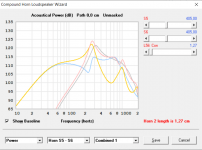
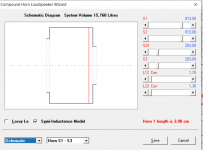
And same with half Sd hole on front and full Sd on the back, same depth. Path length is reduced some and the peak moves up in frequency, not much difference.
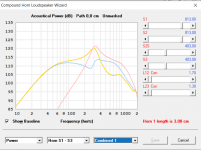
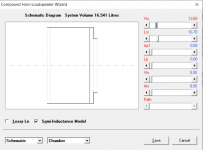
If I lower depth and volume on the back chamber, having 1/2Sd on the front and full Sd on the back the resonances/dipole peak go even further up in frequency and vanish from the power view, but also the lows are now gone.
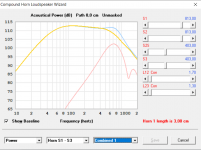
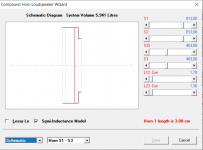
So, takeaway is that if one was to build such speaker play with the back chamber depth and volume, more of it gains more lows but also brings resonances down in frequency. In general usable bandwidth is similar to a open baffle speaker, few octaves down from the "peak", which one can move lower in frequency by increasing path length between the front and backside of the cone.
I played with PPD concept in hornresp. Here is the quick observations:
Power graphs indicate its behaves like OB. Having the apertures gives bit more low end, in other words start to lower the "dipole peak" below which we have the usable bandwidth. This is similar to having reqular OB speaker and widening the baffle, or making a h-frame or something, increased path length between the dipole sources.
Playing around with the back chamber: lowering its volume makes even smoother response which I think is the main selling point here compared to ripole, moves resonance (and dipole) peaks up in frequency. But also the lows are now reduced with it. This is analog to how a dipole speaker works, increase baffle size and the usable bandwidth gets lower in frequency.
Lowering Fs is nice feature of the apertures but make sure there is enough of these boxes in the room to meet SPL requirements and hear the Fs since making the response free of resonances means there is not much lows left due to destructive interference, just like with OB. Its nice there is acoustic low pass due to the apertures, which low passes driver borne distortion as well. Regular OB wouldn't have this feature. On the other hand one could put such aperture on a closed box woofer as well and enjoy same reduced distortion, and possible side-effects.
Based on these quick tests I see the box just OB that is convenient to manufacture. Its bit better concept than OB of similar size due to low passed distortion. Its simple in construction and stays upright nicely, compact stackable form factor.
I'd like it was a good revolutionary system as its very simple and elegant in that way which I like. Unfortunately it doesn't seem to have any magic to it. Perhaps its better than ripole though, as the chambers are different and perhaps less resonant. As disclaimer I have not heard or build OB or PPD or ripole speakers.
Below some hornresp data where the above reasoning is based on. If something is wrong please correct. Did I miss something?
The data:
I'm using hornresp config from post #54 except with 15" driver I have. Its a box that has 1/4Sd aperture on front and 1/2Sd aperture on back. Simple minimal rectangular box wher the driver fully fits in, so quite deep and quite big volume and we have some resonance:


And same with half Sd hole on front and full Sd on the back, same depth. Path length is reduced some and the peak moves up in frequency, not much difference.


If I lower depth and volume on the back chamber, having 1/2Sd on the front and full Sd on the back the resonances/dipole peak go even further up in frequency and vanish from the power view, but also the lows are now gone.


So, takeaway is that if one was to build such speaker play with the back chamber depth and volume, more of it gains more lows but also brings resonances down in frequency. In general usable bandwidth is similar to a open baffle speaker, few octaves down from the "peak", which one can move lower in frequency by increasing path length between the front and backside of the cone.
Few more:
Here is back chamber tuned for lowest resonance, but the low end is gone.
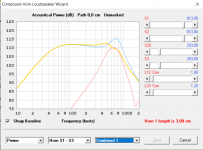
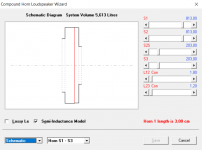
Increasing the back chamber volume I can get more lows but resonance appears, here is with ~6db resonance, much more lows though.
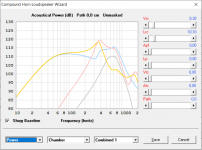
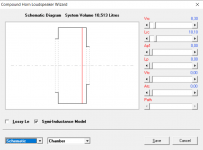
If I just remove the apertures from the above we get rid of the resonance altogether while the lows stay pretty much the same.

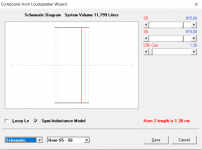
These sims indicate there is not much point using the apertures, they just add resonance compared to simple OB, without obvious benefits. By obvious benefits I mean even if Fs was lowered there is about no sound at Fs, except perhaps its not as simple in a room? Low pass effect seems to be somewhere ~1kHz territory which is quite far out of band of a sub woofer and perhaps about no difference.
I'm not sure if the hornresp model is correct one to use, are the comparisons valid?
Here is back chamber tuned for lowest resonance, but the low end is gone.


Increasing the back chamber volume I can get more lows but resonance appears, here is with ~6db resonance, much more lows though.


If I just remove the apertures from the above we get rid of the resonance altogether while the lows stay pretty much the same.


These sims indicate there is not much point using the apertures, they just add resonance compared to simple OB, without obvious benefits. By obvious benefits I mean even if Fs was lowered there is about no sound at Fs, except perhaps its not as simple in a room? Low pass effect seems to be somewhere ~1kHz territory which is quite far out of band of a sub woofer and perhaps about no difference.
I'm not sure if the hornresp model is correct one to use, are the comparisons valid?
Last edited:
Is there any calculation methode for the wooden enclosure of the PPD sub for different subwoofer chassis?
Best Rgds
Best Rgds
1. Qts
The best Qts for OB is greater than 0.7
Does PPD recommend the best Qts?
Please recommend Qts with DSP? and Qts without DSP?
2. BL, SD
BL, SD as big as possible
Is there a recommended base value at 15"?
How much is big enough?
Thank you very much for your reply and help
The best Qts for OB is greater than 0.7
Does PPD recommend the best Qts?
Please recommend Qts with DSP? and Qts without DSP?
2. BL, SD
BL, SD as big as possible
Is there a recommended base value at 15"?
How much is big enough?
Thank you very much for your reply and help
I missed a question
Are there any rules for the depth of the PPD box?
Thank you for your reply and help

Are there any rules for the depth of the PPD box?
Thank you for your reply and help
Welcome to the topic! I had experience using speakers with Qts from 0.3 to 1.2 in PPD. Therefore, if we focus on the average value, then the optimum will be around 0.6 or 0.71. Qts
Also from my own experience, it follows that BL, MMs and SD have a much greater effect on the final result. BL should be as large as possible, MMs as small as possible. For convenience, you can focus on the ratio of BL to MMs: . A speaker with a value of 0.16 or higher can be considered a good candidate for use in PPD.2. BL, SD
Due to the low efficiency of the PPD, I recommend using heads 10 inches or larger.
One main rule works here, the smaller the volume of the rear chamber, the better the result. Therefore, the depth of the cabinet should be kept small, usually enough to hide the speaker's magnetic system inside for convenience.I missed a question
Are there any rules for the depth of the PPD box?
Couple of question can 2 nos PPD boxes with Beyma 12br70 create pressure in bass upto 100hz to support my 2 way Bookshelf that go down to 70 approx room size
14ft wide 10ft height and 27 ft depth
Can 1 PPD equal or outperform a 30 litre sealed box sub with peerless XLS 10
Can PPD 1 box with Beyma used in a car for sub duty
Thanks in advance
Regards
Anand
14ft wide 10ft height and 27 ft depth
Can 1 PPD equal or outperform a 30 litre sealed box sub with peerless XLS 10
Can PPD 1 box with Beyma used in a car for sub duty
Thanks in advance
Regards
Anand
Yes, they can.can 2 nos PPD boxes with Beyma 12br70 create pressure in bass upto 100hz to support my 2 way Bookshelf that go down to 70 approx room size
Yes, it should be approx. equal but with better sound qualityCan 1 PPD equal or outperform a 30 litre sealed box sub with peerless XLS 10
it depends on the amount of free space and the location of the subwoofer. This is a dipole and will require at least 40-50 cm of free space near the front and rear ports.Can PPD 1 box with Beyma used in a car for sub duty
Therefore, if we focus on the average value, then the optimum will be around 0.6 or 0.7
For convenience, you can focus on the ratio of BL to MMs: . A speaker with a value of 0.16 or higher can be considered a good candidate for use in PPD.
Due to the low efficiency of the PPD, I recommend using heads 10 inches or larger.
According to the above conditions BL(Tm) / Mms(g) > 0.16
I simply call it BMR (BL Mms Ratio)
I compared some 12" and 15" data
BMR>0.16 and QTS>0.6 can find some in 12"
But when the 15" BMR>0.16
Qts mostly 0.2X< Qts <0.5
Then I read this topic several times
I found two PPD to be low BMR
12" (#10)GW212_4
Bl = 4.94
Mms = 45
MBR = 0.1098
Qts = 1.2
15" (#79) Jensen JWS 300 CP
Bl = 9.074043
Mms = 107.11
MBR = 0.0847
Qts = 0.76
Is there a better recommendation for BMR and QTS values at 15"?
Or use "Hornresp" for simulation
What simulation results are available for selection judgment?
Thank you very much for your reply and help
I can't find a style for PPD to set
I only found OB > H-Frame, RIPOLE two styles
Can anyone share the file setting process and simulation steps?
Thank you very much for your reply and help
You have chosen a not very successful abbreviation, since this name is already used by Tectonic speakers . Therefore, there may be confusion among other users.I simply call it BMR (BL Mms Ratio)
I would recommend to try this oneIs there a better recommendation for BMR and QTS values at 15"?
Since PPD is an improved version of ripole, you can make simulations based on ripole, adjusting the necessary values in the simulation for PPDI only found OB > H-Frame, RIPOLE two styles
Do you understand what you are asking? Me nothow many power until xmax?
I'm so sorry I'm just getting startedYou have chosen a not very successful abbreviation, since this name is already used by Tectonic speakers . Therefore, there may be confusion among other users.
I know very little
Or do you think there is a more suitable abbreviation?
I found three speakers that I can easily buyI would recommend to try this one
Which of these three do you recommend?
| 15-172 | 15-1751 | 15-67 | |
| Magnet Dia. | 170 | 170 | 170 |
| Power | 200~400 | 150~300 | 150~300 |
| SPL | 100.8 | 97.5 | 96.6 |
| Fr. Range | 34~2.1K | 34~2.2K | 28~1.8K |
| Xmech??? | 16.7 | 16.7 | 17.3 |
| Fs | 34 | 34 | 28 |
| Re | 5.5 | 7 | 5 |
| Qms | 1.25 | 1.392 | 1.62 |
| Qes | 0.35 | 0.406 | 0.24 |
| Qts | 0.27 | 0.314 | 0.21 |
| BL | 12.5 | 15.8 | 21 |
| Mms | 46 | 76.9 | 124 |
| Cms | 112 | 269 | 253 |
| Vas | 168 | 353 | 325 |
| Sd | 950 | 961 | 950 |
I don't know where to find help files like #38Since PPD is an improved version of ripole, you can make simulations based on ripole, adjusting the necessary values in the simulation for PPD
Taking #38 SICA 12S3PL as an example I can only set this result
I can't find how to set it as PPD style
Could you please upload a simple example file and some simple picture descriptions?
Thank you very much for your reply and help
how much sine wave volt at 20 hz that can make woofer have x max excursion????????????????????Do you understand what you are asking? Me not
Buddy, are you really new to audio? To answer your question, look at the specification of the manufacturer of the speaker whose model you are interested in, or email them this question.how much sine wave volt at 20 hz that can make woofer have x max excursion????????????????????
Hi,
Wik's Q were a perfectly legitimate Q if he had stated which driver worked in what dimensioned PPD.
A well executed simulation and/or a sensible measurement would answer that Q in no time.
Your answer just showed either misunderstanding, disrespect or lack of knowhow.
Since every kind of cabinet alters the drivers parameters, so will be the drivers excursion/Voltage relation.
Beeing an almost freeair cabinet style the excursion of the driver at such low freqs will certainly be high.
I assume it will take less than 10W (resp. ~9V@8R) to push the driver into its excursion limit.
A steep subsonic filter might be advised.
jauu
Calvin
Wik's Q were a perfectly legitimate Q if he had stated which driver worked in what dimensioned PPD.
A well executed simulation and/or a sensible measurement would answer that Q in no time.
Your answer just showed either misunderstanding, disrespect or lack of knowhow.
Since every kind of cabinet alters the drivers parameters, so will be the drivers excursion/Voltage relation.
Beeing an almost freeair cabinet style the excursion of the driver at such low freqs will certainly be high.
I assume it will take less than 10W (resp. ~9V@8R) to push the driver into its excursion limit.
A steep subsonic filter might be advised.
jauu
Calvin
- Home
- Loudspeakers
- Subwoofers
- PPD subwoofer
